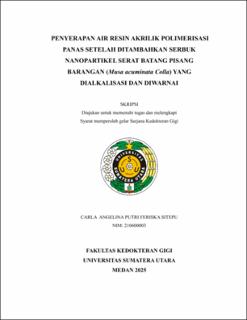Penyerapan Air Resin Akrilik Polimerisasi Panas Setelah Ditambahkan Serbuk Nanopartikel Serat Batang Pisang Barangan (Musa acuminata Colla) yang Dialkalisasi dan Diwarnai
Water Absorption of Heat-Cured Acrylic Resin after the Addition of Alkalized and Dyed Nanoparticle Powder of Barangan Banana Stem Fiber (Musa Acuminata Colla)

Date
2025Author
Sitepu, Carla Angelina Putri Feriska
Advisor(s)
Harahap, Sefty Aryani
Metadata
Show full item recordAbstract
Water absorption is one of the material properties that causes dimensional changes in
heat-cured acrylic resin, affecting the stability and aesthetics of dentures. The addition
of natural fibers, such as banana stem fibers (Musa acuminata Colla), as a reinforcing
agent in acrylic resin is expected to improve its physical and mechanical properties.
This study aims to analyze the differences in water absorption of cured acrylic resin
after the addition of alkali-treated and dyed banana stem fiber nanopowder at
concentrations of 0.5%, 1%, and 1.5% by weight. The research specimens consisted of
heat- acrylic resin discs with a diameter of 50 ± 1 mm and a thickness of 0.5 ± 0.05
mm. A total of 40 specimens (n=10 per group) were divided into four groups: Without
fiber addition, 0.5% fiber powder by weight, 1% fiber powder by weight, and 1.5%
fiber powder by weight, added to the acrylic resin powder. The fibers were extracted
from banana stems, alkali-treated with 5% NaOH at 25°C for 1 hour, dyed with 15%
red dragon fruit extract, ground, dried, and processed using ball milling. The acrylic
mixture was then placed into molds and cured. Water absorption was measured using
the formula according to ISO No. 1567:1999. The mean and standard deviation values
of water absorption for Groups I, II, III, and IV were 5.32±2.18 μg/mm³, 4.73±2.40
μg/mm³, 4.50±3.21 μg/mm³, and 2.11±2.15 μg/mm³, respectively. Statistical analysis
using one-way ANOVA showed a significant difference in water absorption among the
groups after the addition of banana stem fiber nanopowder at concentrations of 0.5%,
1%, and 1.5% by weight, with a p-value of 0.038 (p<0.05). Post hoc analysis revealed
significant differences (p<0.05) between Group I and Group IV (p = 0.007), Group II
and Group IV (p = 0.026), and Group III and Group IV (p = 0.041). Thus, it can be concluded that the higher the concentration of fiber powder added to the acrylic resin
powder, the lower the water absorption value. The 1.5% by weight concentration was
found to be the best in achieving the lowest water absorption value.
Collections
- Undergraduate Theses [1908]
